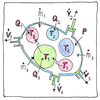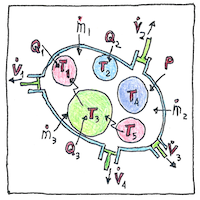Benjamin Thompson, Nicolas Léonard Sadi
Carnot, James Prescott
Joule, Rudolf Clausius
thermodynamics

|
Laws of thermodynamics
Benjamin Thompson had observed that boring cannon barrels produced prodigious heat, and Nicolas Léonard Sadi Carnot had shown that the work that a heat engine can do depends on only the temperature difference inside the engine, but the relationship between heat and work was not well understood. Scientists described heat as a weightless fluid, called caloric, flowing through matter without mechanical potential. But James Prescott Joule carefully measured the heat generated by stirring water learning that both heat and work transfer energy and that no energy is lost in the transfer, and Rudolf Clausius observed that heat doesn’t flow from a cold object to a hot one and claimed that the entropy of the universe tends to a maximum. We go from a few things that are fast and hot to many that are slow and tepid; yet, somehow, living things reject enough disorder to survive.
Energy
Excited atoms bump into each other like billiard balls on springs, like a crowd of people excited by good news communicated from head to head. The first proton and electron bumping together to make a hydrogen isotope; the first smoke arising from sticks rubbed together to make a fire in a cold cave; the laying on of hands that passed the Holy Spirit from disciple to disciple. You’re excited when you hear it. Even thinking about it consumes calories. I pour the boiling water over the leaves. After it steeps, the hot bitter brown liquid jazzes me up.
Precedents
The baker’s son becomes a baker; the president’s a president. Bred to breed we desire what our progenitors desired and thwart our instincts only to thwart ourselves. And, yet, we no longer live in trees but in towers built by others and can fall from them.



I admire geniuses that can realize the truth even though it is not intuitive, and the researcher who doggedly pursues the impossible; however, gullible people are easily be misled by con artists. It would be nice if such deceptions were to cause less damage than the entertainment and hope they offer.
In my pursuit of the principle of perpetual motion, the science of thermodynamics has been like a dog barking at my heels. When we want to convert nothing into something, thermodynamics points out that we will lose energy with every conversion. There can be no overunity generator, no machine that generates more energy than it takes to run it. Nevertheless, organisms organize available energy, and there is plenty of energy to be organized.
See also in The book of science:
Readings in wikipedia: